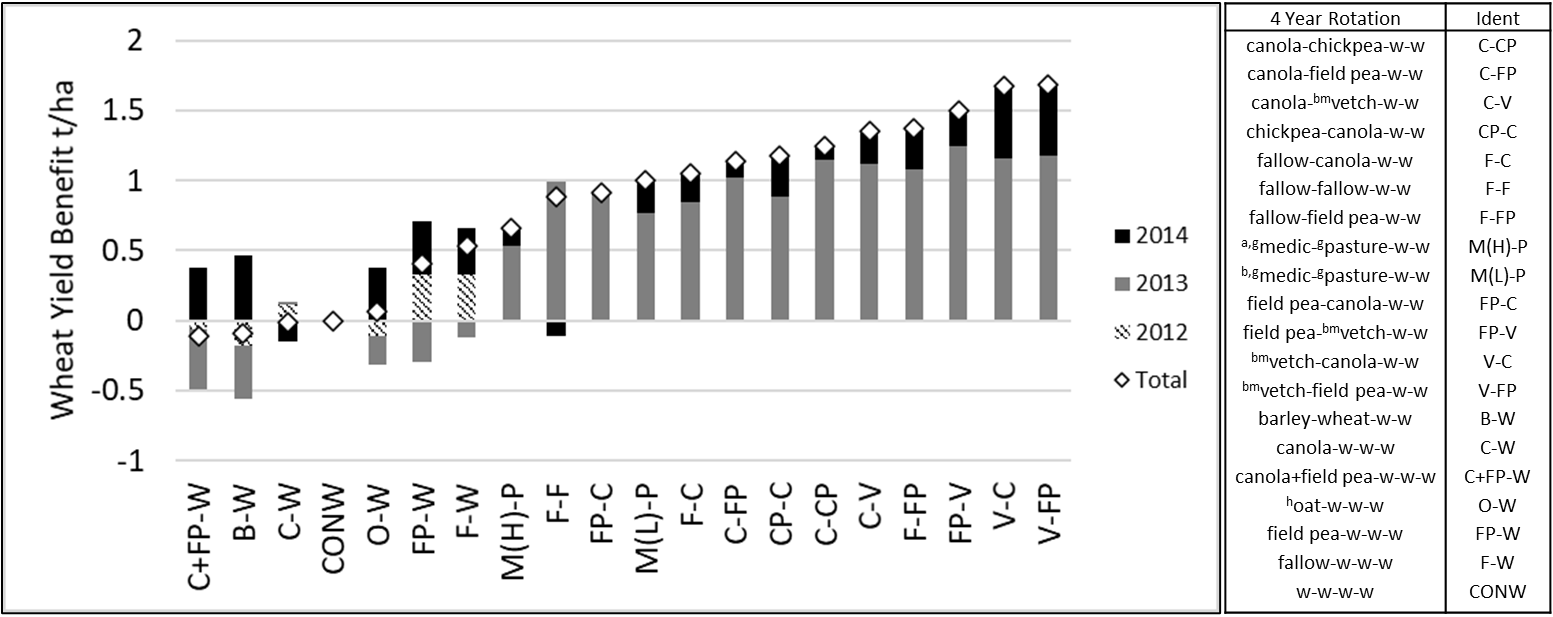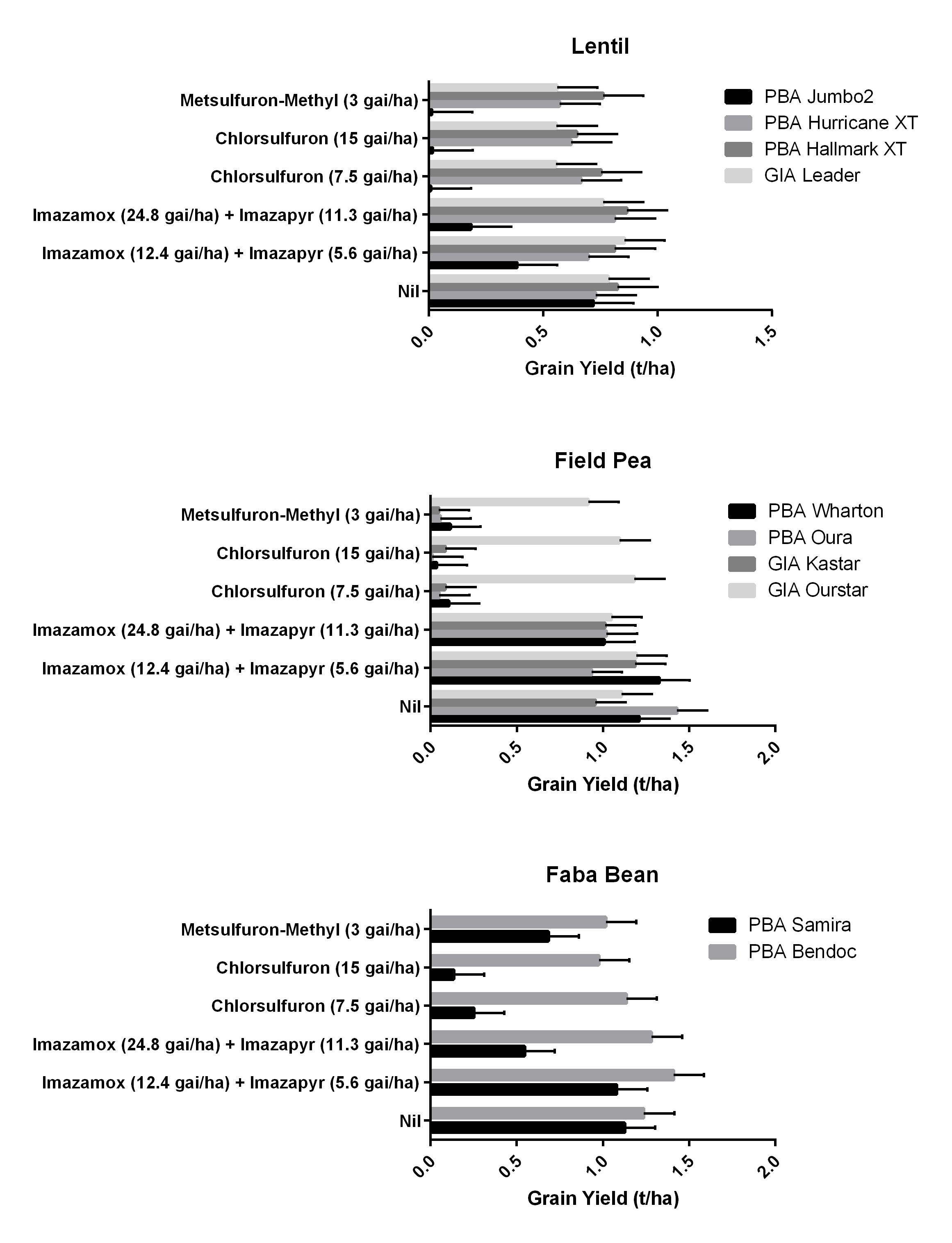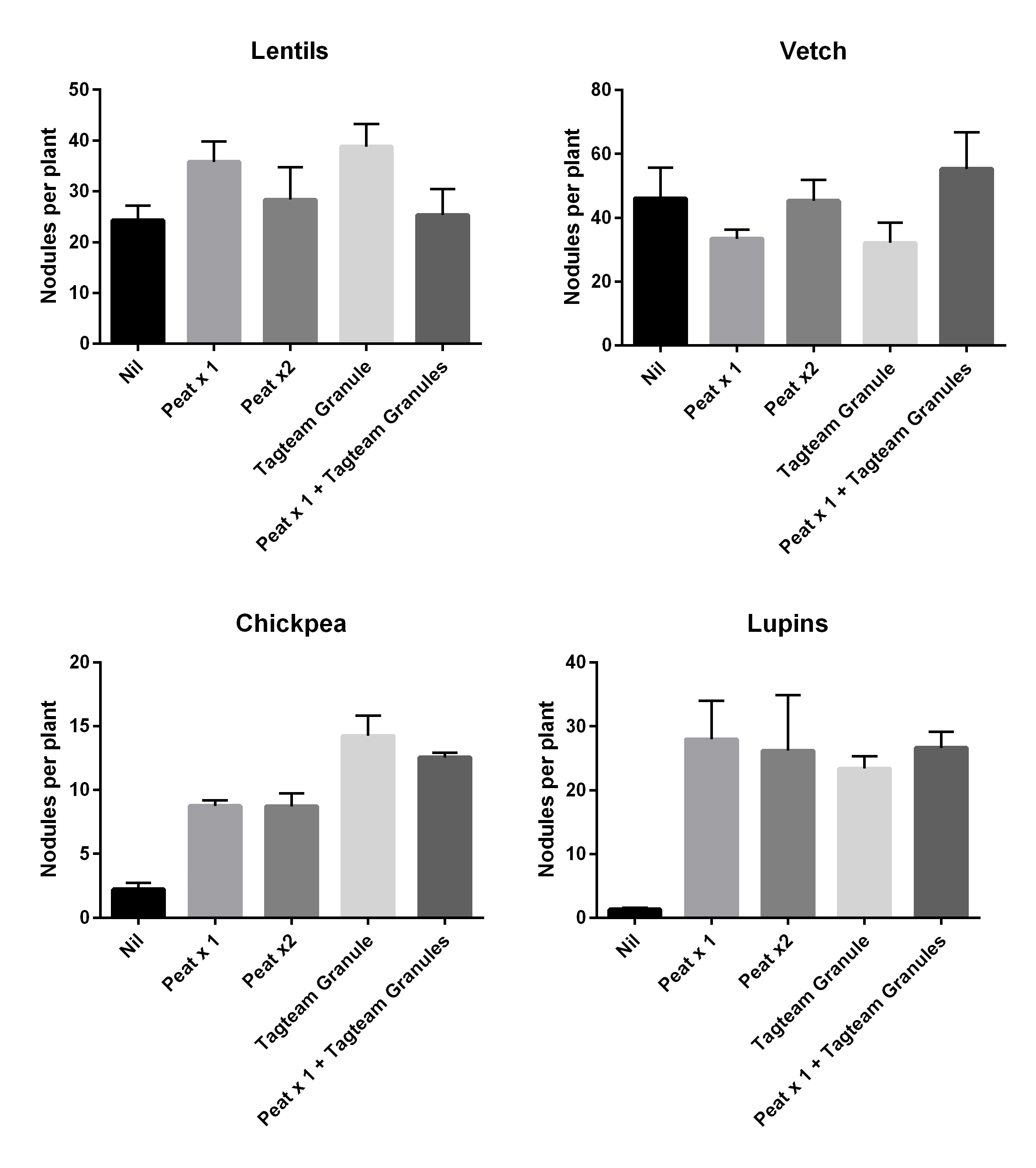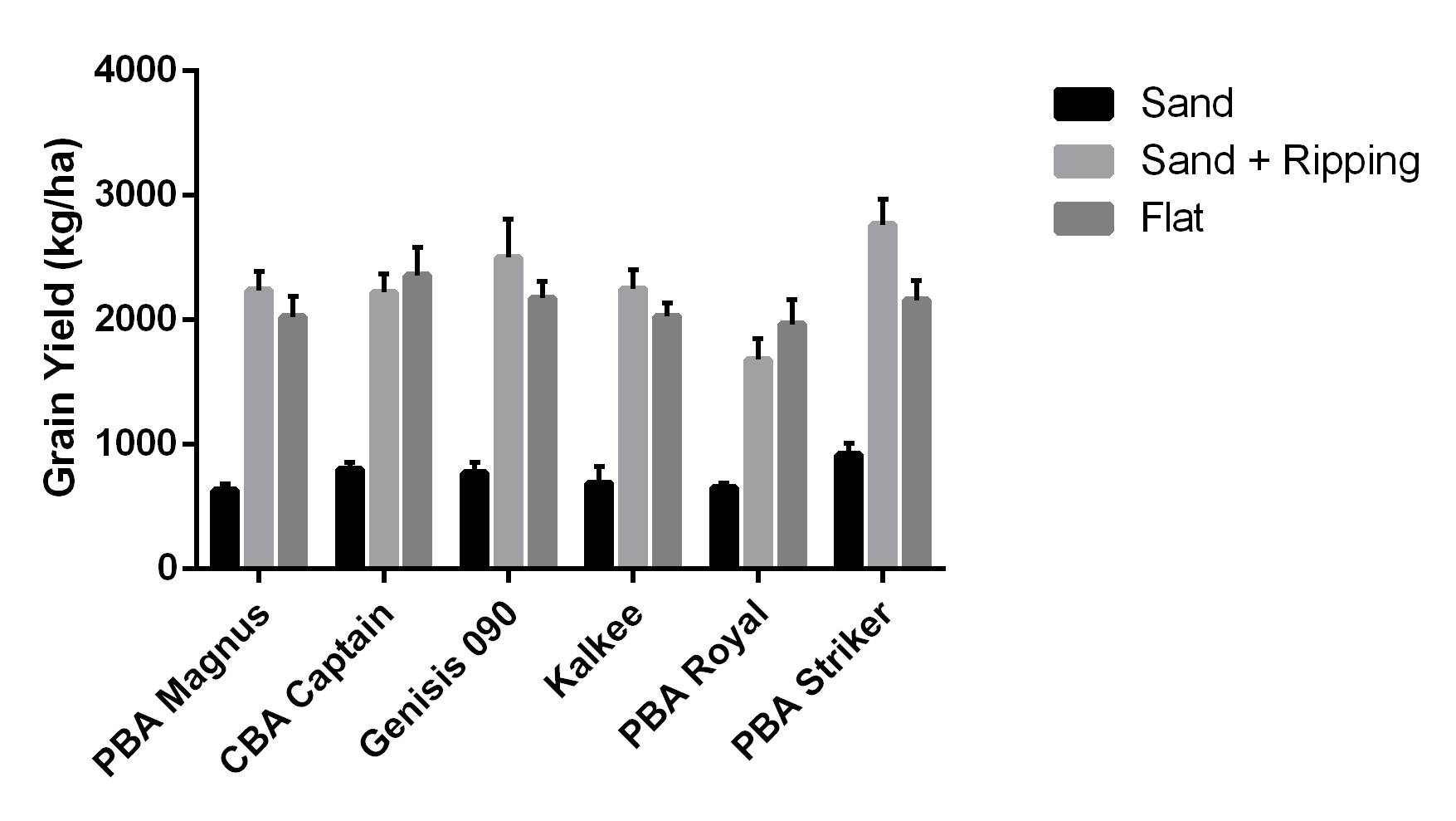Profitable pulses in lower rainfall farming systems
Author: Michael Moodie, Frontier Farming Systems | Date: 17 Feb 2021
Take home messages
- Pulse crops contribute to increased productivity and profitability of low rainfall crop sequences by reducing constraints to subsequent crops. This benefit is commonly 0.5-1.5 t/ha depending on the level of constraints
- Over the long term it is predicted that lentils are likely to be the most profitable and lowest risk break crop in the low rainfall zone, however all crop sequences need diversity to counter seasonal climate and price risks
- Sowing pulse crops in late April – mid May has typically provided the best balance of optimising biomass accumulation and reducing frost risk to maximise grain yields
- Pulse crops typically contribute ~50 kg N/ha through net fixed nitrogen inputs to low rainfall farming systems
- Addressing local soil constraints has demonstrated large increases in the productivity of pulses, for example deep ripping Mallee sands increased chickpea yields from 0.5 t/ha to 2 t/ha.
Pulse crops contribute to the profitability of low rainfall farming systems by two mechanisms:
- Improved profitability of the crop sequence through providing break crop effects
- As a profitable enterprise in their own right.
Break crop effects
Pulse crops contribute the productivity and profitability of the cropping sequence by reducing the impact of agronomic constraints on subsequent crops. They provide multiple pathways to control grass weeds, contribute biologically fixed N, can reduce soil borne disease and, in some cases, provide a positive water balance. A long term rotation trial conduced at near Mildura from 2011-2014 demonstrated the production and profitability benefits of addressing agronomic constraints with the use of break crops, including pulses. In this trial the inclusion of a a double break phase in 2011 and 2012 resulted in increased wheat production of between 0.6 – 1.6 t/ha in 2013 and 2014 (Figure 1). This is despite relatively low yields of the continuous wheat treatments of less than 1.4 t/ha. The choice of break phase appeared to have little effect on the break effect as it successfully addressed the biological constraints present. At Mildura, the top five rotations increased gross margin by an average of $320/ha over the four years or approximately $80/ha/year. Key attributes of the most profitable crop sequences were having at least one profitable break crop and that the break phase delivered large yield benefits to subsequent wheat crops.
 Figure 1. Wheat yield benefit (treatment wheat yield – continuous wheat yield) achieved at the Mildura site following one and two year break phase. Yields of the continuous wheat treatment (CONW) were 0.93, 1.42 and 1.31 t/ha in 2012, 2013 and 2014 respectively.
Figure 1. Wheat yield benefit (treatment wheat yield – continuous wheat yield) achieved at the Mildura site following one and two year break phase. Yields of the continuous wheat treatment (CONW) were 0.93, 1.42 and 1.31 t/ha in 2012, 2013 and 2014 respectively.
Comparative pulse crop productivity and profitability
To understand the financial risk of growing pulse crops in the longer term, a gross margin analysis was undertaken using Monte Carlo simulation with the Microsoft Excel add-in @Risk. Data was combined from several Mallee sites with mean annual rainfall of less than 330 mm where all pulse crops had been grown on a sandy loam soil type over the eight seasons (2013 – 2020). This data was then analysed to generate a long-term yield probability using a gamma distribution. A long-term grain price distribution (log logistic) was also developed for each crop using long-term (2003 – 2020) average January grain price from the Farm gross margin and enterprise planning guide (Rural Solutions). A gross margin analysis was then repeated 5000 times for each crop, drawing a new random yield by price combination each time from the distributions described above to generate a new gross margin distribution. Each yield output for the sandy loam soil type was moderated by 30% to account for typical within paddock variability where both heavier and lighter soil types are less favourable for pulse production. The outcome of this analysis is shown in Table 1.
This analysis shows than lentils are predicted to be both the most profitable and least risky pulse crop grown in the long term. The average long term gross margin for lentils is predicted as $365, however importantly a negative gross margin is expected only 15% of the time. Conversely lentils also have a strong possibility of achieving a high gross margin with a gross margin of more than $500/ha probable 28% of the time.
Vetch was the next most profitable break crop with an average gross margin of $255/ha (Table 1). However, vetch as grain is predominantly sold for seed to plant fodder and hay crops. While there have been some high prices received for vetch, the grain market is limited and becomes easily flooded, which is not reflected in the @Risk simulation.
Chickpea and field pea had similar profitability and risk outcomes with both having a mean long-term gross margin of about $200/ha (Table 1). Both crops also had similar risk of not achieving a break-even gross margin (25%) while both crops had an 15% probability of the gross margin exceeding $500/ha. Despite both crops having a similar profitability and risk profile, our observations from the trials were that they could be complementary within a farm enterprise mix. Field pea which flowers and matures earlier tended to perform well in frost-free situations with terminal drought and/or high levels of heat in spring. Conversely, chickpea which flowers and matures later, performed well at sites which were frosted in early spring or in situations where soil moisture was available late in the season.
Lupin and faba bean had lowest simulated long-term gross margins of $65/ha (Table 1). Faba bean were also the riskiest crop and are expected to not break even in 49% of seasons. Lupin has the lowest probability of achieving a high gross margin of more than $500/ha. This is due to low long term price outcomes for lupins relative to other pulse crops.
Table 1. Mean gross margins for pulse crops and the probability of gross margin which are less than $0/ha or greater than $500/ha generated from Mallee sites with less than 330 mm annual rainfall.
Crop | Mean ($/ha) | Probability gross margin <$0/ha | Probability gross margin $0 - $500/ha | Probability gross margin >$500/ha |
|---|---|---|---|---|
Lentil | 365 | 15% | 57% | 28% |
Vetch | 255 | 23% | 60% | 15% |
Chickpea | 220 | 24% | 60% | 15% |
Field Pea | 174 | 27% | 62% | 10% |
Faba Bean | 65 | 49% | 46% | 5% |
Lupin | 65 | 40% | 58% | 2% |
Agronomic options to improve pulse profitability
Sowing time
Sowing pulse crops in late April to mid-May has frequently delivered a yield advantage over sowing pulse crops in the later part of May or early June. This yield benefit is particularly pronounced in seasons with limited spring rainfall. However, when spring is favourable, the effect of sowing time on grain yield is often negated. Time of sowing of pulses in the low rainfall zone is often a compromise between sowing early enough to accumulate adequate biomass and delaying sowing to avoid frost. Figure 2 presents data from Loxton in 2019 where lentil yields were maximised from early sowing despite higher levels of frost damage (percentage of frosted pods). In this example early sowing lead to higher biomass and harvest index (due to terminal spring drought). Sowing on the 26 April (time of sowing (TOS) 2) provided the maximum combination of grain yield, biomass production, harvest index and frost damage, although there was no significant difference for yield, biomass or harvest index between TOS 1 and 2, despite more frost damage in TOS 1.
 Figure 2. Effect of sowing date on the grain yield, biomass, harvest index and frost damage of lentils at Loxton (SA) in 2019. The sowing dates were time of sowing (TOS) 1: 17 April; TOS 2: 26 April; TOS 3: 6 May; TOS 4; 13 May. Data is averaged across 6 varieties: PBA Hurricane XT, PBA Jumbo2, PBA Bolt, PBA HighlandXT, PBA Ace and PBA HallmarkXT.
Figure 2. Effect of sowing date on the grain yield, biomass, harvest index and frost damage of lentils at Loxton (SA) in 2019. The sowing dates were time of sowing (TOS) 1: 17 April; TOS 2: 26 April; TOS 3: 6 May; TOS 4; 13 May. Data is averaged across 6 varieties: PBA Hurricane XT, PBA Jumbo2, PBA Bolt, PBA HighlandXT, PBA Ace and PBA HallmarkXT.
Managing herbicide residues
Herbicide residues are an important constraint to the integration of pulse crops into low rainfall farming systems. Soils within the low rainfall zone often are low in organic carbon and the topsoil can remain dry for prolonged periods. These conditions do not favour microbial breakdown of herbicides and residues of some herbicides may persist in the soil for several seasons post application. Leading pulse growers undertake careful planning of their crop sequences several seasons before they intend to grow a pulse crop, and many have even excluded the use of the highest risk residual herbicides such as sulfonylureas and clopyralid.
Several pulse crops now have commercial varieties with herbicide tolerant (HT) traits which can assist in establishing crops into soils containing herbicide residues. Currently available varieties are tolerant to Group B imidazolinone herbicides, however breeding programs are developing pulse crops and varieties with tolerances to Group I (e.g. clopyralid) and Group C (e.g. metribuzin) herbicides.
The tolerance of crops and varieties to Group B herbicide residues were evaluated at Pinnaroo (SA) in 2019. Four varieties of lentils and field pea and two varieties of faba beans were included in the trial (Table 2).
Table 2. Conventional and herbicide tolerant lentil, field pea and faba bean varieties included in the Group B herbicide residue trial at Pinnaroo (SA) in 2019.
Crop | Conventional | Herbicide tolerant | |||
|---|---|---|---|---|---|
Lentil | PBA Jumbo2 | PBA Hurricane XT | PBA Hallmark XT | GIA Leader | |
Field pea | PBA Wharton | PBA Oura | GIA Kastar | GIA Ourstar | |
Faba bean | PBA Samira | PBA Bendoc | |||
Approximately one month prior to sowing, herbicides were applied to the soil surface to simulate residue treatments and the impact of the simulated residues on pulse grain yield (Figure 3). It should be noted that this application timing is generally well within labelled plantback periods for conventional varieties, and therefore ‘off-label’. There is currently no published plantback periods for the HT varieties to these herbicides. This trial methodology is likely to provide a worst-case scenario for herbicide residues to affect establishment, however may not fully replicate historical field applications. Group B herbicides do not bind strongly to organic matter or soil binding sites and are highly water-soluble. As such, they are prone to leaching down the profile over time. Commercial applications made in previous season crops are likely to be distributed to greater depths within a soil profile than has occurred within this simulation trial where treatments were applied one month prior to sowing.
As would be expected, the grain yield of the conventional lentil variety PBA Jumbo2 was significantly reduced by the presence of both imidazolinone and sulfonylurea herbicides (Figure 3). In contrast the three HT lentil lines-maintained yield potential in the presence of group B residues. Although there appeared to be a slight reduction in grain yield from sulfonylurea residues, this was not statistically significant.
For field peas, the HT variety GIA Ourstar demonstrated a high level of tolerance to all simulated group B residues while GIA Kastar maintained grain yield only in the presence of imidazolinone residues. Both conventional lines (PBA Wharton and PBA Oura) demonstrated some inherent tolerance to imidazolinone residues.
The grain yield of the HT faba bean variety PBA Bendoc was not significantly affected by any of the simulated group B residues. The conventional variety PBA Samira withstood low levels of imidazolinone residues (12.4gai/ha imazamox + 5.6gai/ha imazapyr), however significant grain yield reductions were evident where the high rates were simulated or where metsulfuron-methyl was applied. Chlorsulfuron residues resulted in near crop failure of PBA Samira.
 Figure 3. Effect of simulated Group B herbicide residues on the grain yield of lentil, field pea and faba bean varieties at Pinnaroo (SA) in 2019. Error bars represent the LSD (P<0.05).
Figure 3. Effect of simulated Group B herbicide residues on the grain yield of lentil, field pea and faba bean varieties at Pinnaroo (SA) in 2019. Error bars represent the LSD (P<0.05).
Nitrogen fixation and inoculation
Pulse crops can contribute significant fixed nitrogen inputs to low rainfall farming systems with the net input being a function of the amount of nitrogen fixed by the pulse crop and the level of export from the paddock through products such as grain and hay. Over three seasons (2013-2015) break crop comparison trials were sampled to measure dry matter (DM) production and symbiotic N2 fixation of chickpea, field pea, lentil, lupin, faba bean and vetch crops grown in the Victorian and South Australian Mallee. After taking account of the amount of nitrogen removed in harvested grain across the three seasons and including estimates of the likely contributions of fixed nitrogen associated with the nodulated roots, all except three of the 15 legume treatments were calculated to have provided agronomically significant (> 10 kg N/ha) net inputs of fixed nitrogen for the potential benefit of following crops (Figure 4). The average net input of fixed nitrogen across all legume crops and seasons was ~50 kg N/ha; however, the average for all crops varied between 17 and 103 kg N/ha between seasons. Based on an average cereal yield of 1.6 t/ha and nitrogen removal of 32 kg N/ha per year during the cereal phase, soil nitrogen reserves could perhaps be maintained if one to two cereal crops were grown for every grain legume phase in this environment. Such intensity would present challenges both for farm business risk and profitability in the low rainfall zone and could also lead to agronomic issues such as legume disease build up and broadleaf weed problems arising from such frequent phases of legume crops in paddocks. Therefore, farmers need to consider a wider range of options than pulse crops alone to maintain the nitrogen balance and soil fertility in the low rainfall regions. Such options could include legume pastures, legume crops sown for forage or manuring and supplementary nitrogen fertiliser strategies.

Nitrogen fixation by pulse crops requires adequate nodulation of the legume plants roots. This requires an appropriate background population of rhizobia, or for the correct rhizobia to be introduced through inoculation of pulse seed at sowing time. In the low rainfall farming systems, slurry inoculation with peat inoculants can be problematic, especially when farmers have large seeding programs or are sowing into dry soil conditions. In 2020 a trial was undertaken at Kooloonong to evaluate inoculation strategies for Mallee sandy soils. Prior to sowing the background soil rhizobium level was measured and it showed that levels were adequate for lentils and vetch (group E/F), however chickpea (group N) and lupin (group G) were likely to be responsive. These four crops were subsequently sown without inoculant; or with peat slurry (Nodulaid®); or in furrow granule (TagTeam ®granular) treatments. Subsequent assessments showed a significant response in the number of nodules per plant in chickpea and lupin with inoculants but not vetch or lentils (Figure 5) which confirmed the predictions of the pre sowing soil test. Another important result of the trial was the generally equivalent performance of the granule product relative to the peat slurry (Figure 5). In chickpea we often see that granules promote more nodules per plant than peat-based inoculants, however nodules are smaller and therefore the nodule weight per plant is often similar. Although there is additional cost for granule products relative to peat slurry inoculation, the granule products provide a useful option in dry sowing conditions where rhizobia survival in a peat slurry may be compromised. Another potential use for granulated products is to boost the rhizobium levels of certain high risk soil types within the paddock using variable rate technology.
 Figure 5. Effect of inoculant treatment on the number of nodules per plant for lentil, vetch, chickpea, and lupin grown on a deep ripped sand at Kooloonong in 2020. Error bars are standard error’s
Figure 5. Effect of inoculant treatment on the number of nodules per plant for lentil, vetch, chickpea, and lupin grown on a deep ripped sand at Kooloonong in 2020. Error bars are standard error’s
Soil constraints
Pulse crops can be extremely sensitive to soil constraints such as saline and waterlogged soils. In the low rainfall Mallee region, the deep sandy soils which comprise 20-30% of most paddocks have been a major constraint to pulse production. Recent research has highlighted that reducing soil penetration resistance though practices such as deep ripping has led to substantial productivity gains of pulses on these deep sands. For example, chickpea grain yield on an un-ripped deep sand at Kooloonong in 2020 was about one third of the yield achieved on the sandy clay loam (flat) soil nearby within the same paddock (Figure 6). When deep ripping to 50 cm prior to sowing, chickpea grain yield on the ripped sand was improved by over 1.5 t/ha and was equal to or better than what was achieved on the flat (Figure 6). This example highlights the potential benefit from careful investigation of soil constraints and strategies to address these to improve pulse production in the low rainfall zone.
 Figure 6. Effect of soil type and deep ripping sandy soils on the grain yield of chickpea varieties at Kooloonong in 2020.
Figure 6. Effect of soil type and deep ripping sandy soils on the grain yield of chickpea varieties at Kooloonong in 2020.
Acknowledgements
The research undertaken as part of this project is made possible by the significant contributions of growers through both trial cooperation and the support of the GRDC, the author would like to thank them for their continued support.
Research included in this report has also been supported by the South Australian Grains Industry trust though the following projects:
- MSF 218: Investigating frost susceptibility on Clearfield® varieties treated with imidazolinone herbicide
- MSF 115: Adopting profitable crop sequences in the South Australian Mallee
Thank you to Jason Brand and the wider Southern Pulse Agronomy team for their important input into the pulse research and development activities in the low rainfall zone.
Contact details
Michael Moodie
Frontier Farming Systems
7B Byrne Court, Mildura
Ph: 0448 612 892
Email: michael@frontierfarming.com.au
Varieties displaying this symbol beside them are protected under the Plant Breeders Rights Act 1994.
® Registered trademark
GRDC Project Code: DAS00119, 9176601, DAV1706-003RMX,
Was this page helpful?
YOUR FEEDBACK
